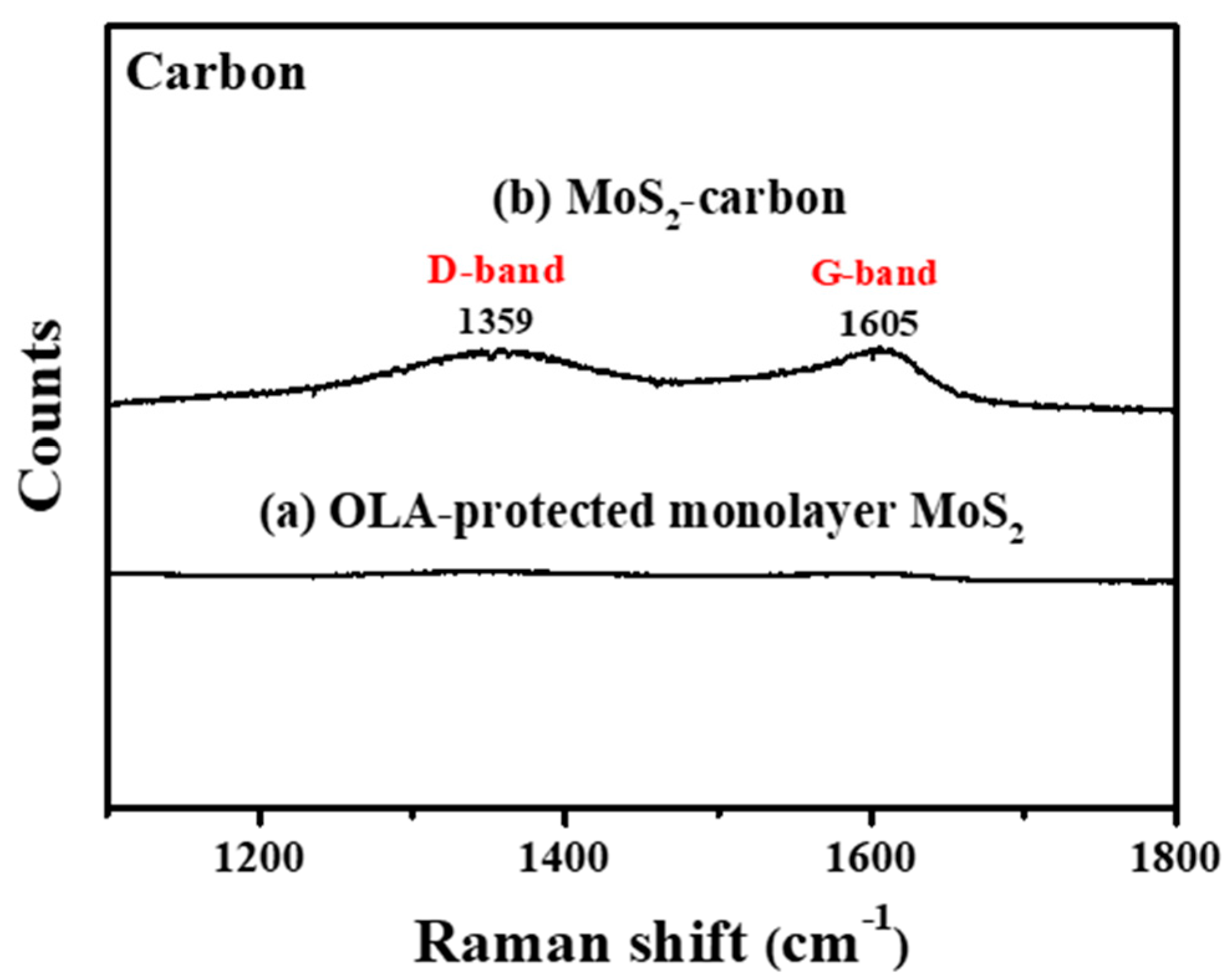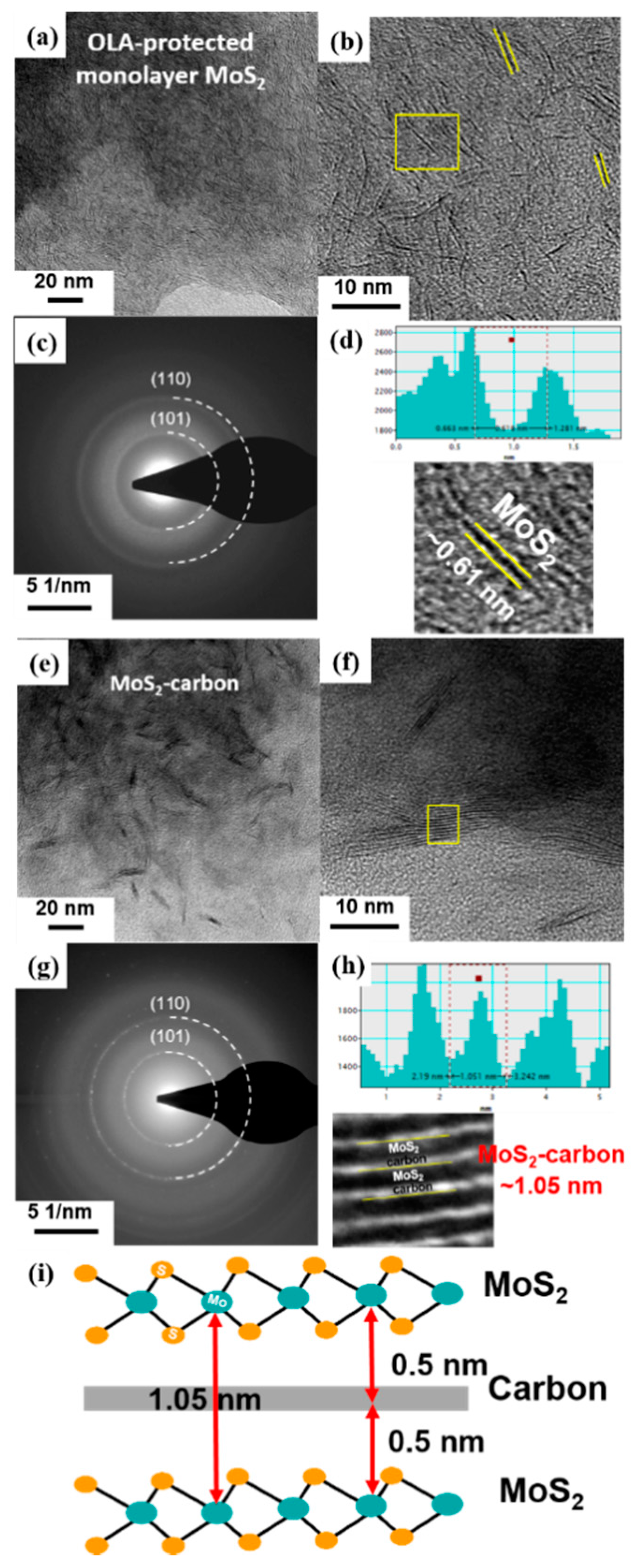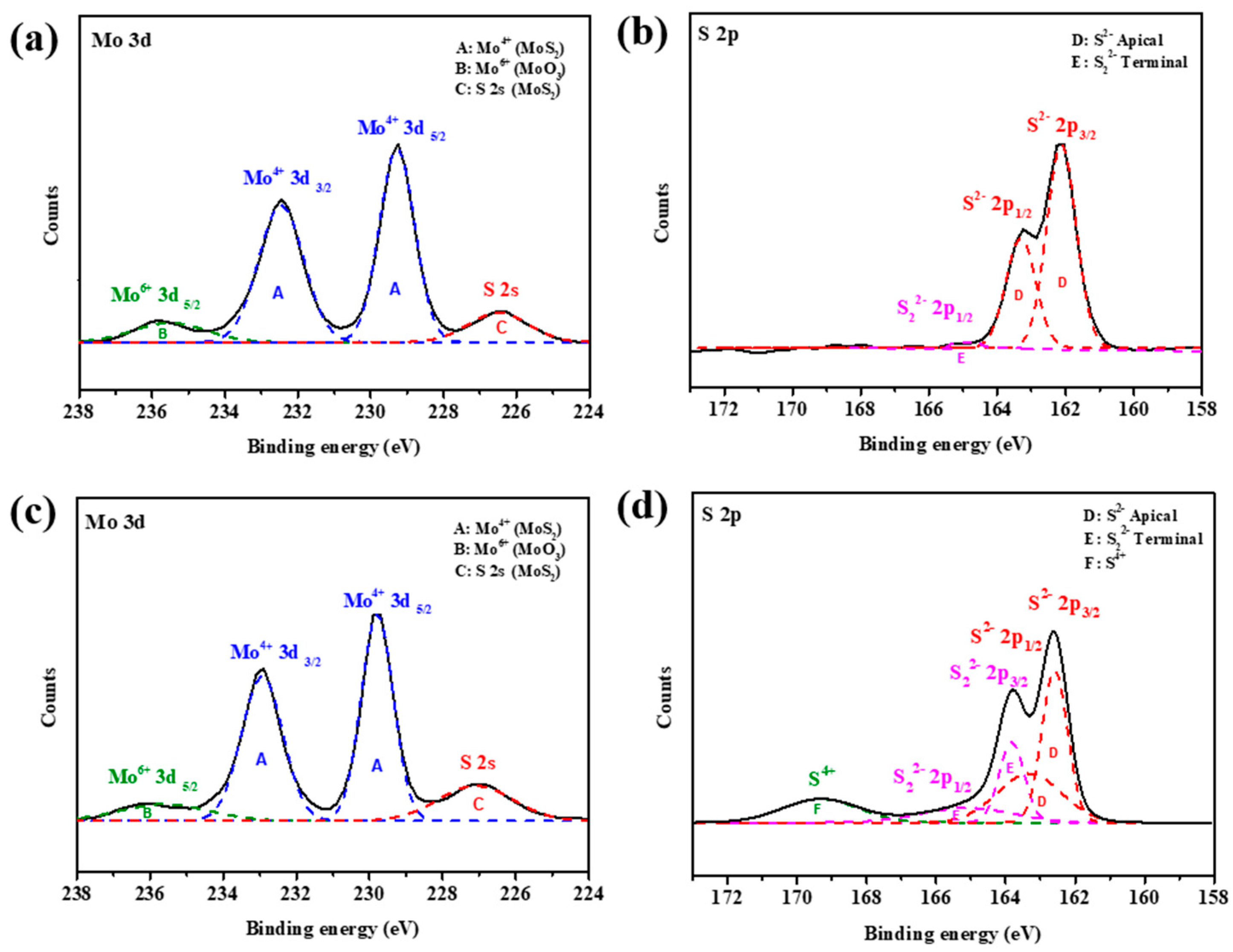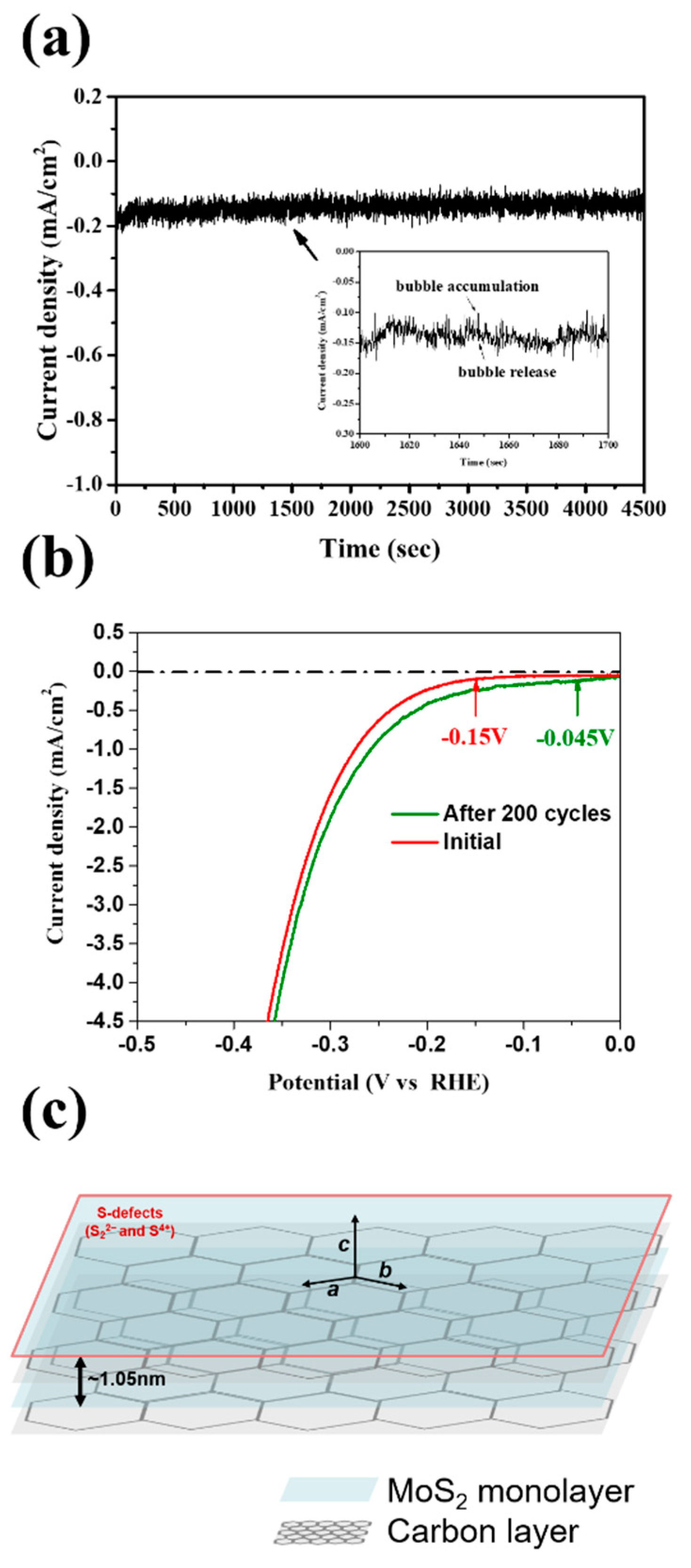MoS2-Carbon Inter-overlapped Structures as Effective Electrocatalysts for the Hydrogen Evolution Reaction
Abstract
1. Introduction
2. Materials and Methods
2.1. Preparation of OLA-Protected Monolayer MoS2
2.2. Preparation of MoS2-Carbon Inter-Overlapped Structure
2.3. Characterization
2.4. Electrochemical Measurement
3. Results and Discussion
3.1. Phase and Chemical Bonding Analyses
3.2. Microstructure Analysis
3.3. Elemental Composition and Valence State
3.4. Electrocatalytic HER Performance
4. Conclusions
Author Contributions
Funding
Acknowledgments
Conflicts of Interest
References
- Wang, F.M.; Shifa, T.A.; Zhan, X.Y.; Huang, Y.; Liu, K.L.; Cheng, Z.Z.; Jiang, C.; He, J. Recent advances in transition-metal dichalcogenide based nanomaterials for water splitting. Nanoscale 2015, 7, 19764–19788. [Google Scholar] [CrossRef] [PubMed]
- Gao, M.R.; Xu, Y.F.; Jiang, J.; Yu, S.H. Nanostructured metal chalcogenides: Synthesis, modification, and applications in energy conversion and storage devices. Chem. Soc. Rev. 2013, 42, 2986–3017. [Google Scholar] [CrossRef] [PubMed]
- Lu, Q.P.; Yu, Y.F.; Ma, Q.L.; Chen, B.; Zhang, H. 2D Transition-Metal-Dichalcogenide-Nanosheet-Based Composites for Photocatalytic and Electrocatalytic Hydrogen Evolution Reactions. Adv. Mater. 2016, 28, 1917–1933. [Google Scholar] [CrossRef] [PubMed]
- Antolini, E. Palladium in fuel cell catalysis. Energy Environ. Sci. 2009, 2, 915–931. [Google Scholar] [CrossRef]
- Briggs, N.; Subramanian, S.; Lin, Z.; Li, X.F.; Zhang, X.T.; Zhang, K.H.; Xiao, K.; Geohegan, D.; Wallace, R.; Chen, L.Q.; et al. A roadmap for electronic grade 2D materials. 2D Mater. 2019, 6, 022001. [Google Scholar] [CrossRef]
- Anjum, M.A.R.; Jeong, H.Y.; Lee, M.H.; Shin, H.S.; Lee, J.S. Efficient Hydrogen Evolution Reaction Catalysis in Alkaline Media by All-in-One MoS2 with Multifunctional Active Sites. Adv. Mater. 2018, 30. [Google Scholar] [CrossRef] [PubMed]
- Liu, M.M.; Zhang, C.C.; Su, J.M.; Chen, X.; Ma, T.Y.; Huang, T.; Yu, A.S. Propelling Polysulfide Conversion by Defect-Rich MoS2 Nanosheets for High-Performance Lithium-Sulfur Batteries. Acs Appl. Mater. Interfaces 2019, 11, 20788–20795. [Google Scholar] [CrossRef]
- Thangasamy, P.; Oh, S.; Nam, S.; Oh, I.K. Rose-like MoS2 nanostructures with a large interlayer spacing of similar to 9.9 angstrom and exfoliated WS2 nanosheets supported on carbon nanotubes for hydrogen evolution reaction. Carbon 2020, 158, 216–225. [Google Scholar] [CrossRef]
- Tsai, C.; Chan, K.R.; Norskov, J.K.; Abild-Pedersen, F. Theoretical insights into the hydrogen evolution activity of layered transition metal dichalcogenides. Surf. Sci. 2015, 640, 133–140. [Google Scholar] [CrossRef]
- Wu, M.H.; Zhan, J.; Wu, K.; Li, Z.; Wang, L.; Geng, B.J.; Wang, L.J.; Pan, D.Y. Metallic 1T MoS2 nanosheet arrays vertically grown on activated carbon fiber cloth for enhanced Li-ion storage performance. J. Mater. Chem. A 2017, 5, 14061–14069. [Google Scholar] [CrossRef]
- Senthil, C.; Amutha, S.; Gnanamuthu, R.; Vediappan, K.; Lee, C.W. Metallic 1T MoS2 overlapped nitrogen-doped carbon superstructures for enhanced sodium-ion storage. Appl Surf. Sci 2019, 491, 180–186. [Google Scholar] [CrossRef]
- Shi, S.L.; Sun, Z.X.; Hu, Y.H. Synthesis, stabilization and applications of 2-dimensional 1T metallic MoS2. J. Mater. Chem. A 2018, 6, 23932–23977. [Google Scholar] [CrossRef]
- Geng, X.M.; Zhang, Y.L.; Han, Y.; Li, J.X.; Yang, L.; Benamara, M.; Chen, L.; Zhu, H.L. Two-Dimensional Water-Coupled Metallic MoS2 with Nanochannels for Ultrafast Supercapacitors. Nano Lett. 2017, 17, 1825–1832. [Google Scholar] [CrossRef] [PubMed]
- Liu, Q.; Li, X.L.; He, Q.; Khalil, A.; Liu, D.B.; Xiang, T.; Wu, X.J.; Song, L. Gram-Scale Aqueous Synthesis of Stable Few-Layered 1T-MoS2: Applications for Visible-Light-Driven Photocatalytic Hydrogen Evolution. Small 2015, 11, 5556–5564. [Google Scholar] [CrossRef]
- Tsai, C.; Abild-Pedersen, F.; Nørskov, J.K. Tuning the MoS2 edge-site activity for hydrogen evolution via support interactions. Nano Lett. 2014, 14, 1381–1387. [Google Scholar] [CrossRef]
- Laursen, A.B.; Kegnæs, S.; Dahl, S.; Chorkendorff, I. Molybdenum sulfides—Efficient and viable materials for electro-and photoelectrocatalytic hydrogen evolution. Energy Environ. Sci. 2012, 5, 5577–5591. [Google Scholar] [CrossRef]
- Fan, X.B.; Xu, P.T.; Zhou, D.K.; Sun, Y.F.; Li, Y.G.C.; Nguyen, M.A.T.; Terrones, M.; Mallouk, T.E. Fast and Efficient Preparation of Exfoliated 2H MoS2 Nanosheets by Sonication-Assisted Lithium Intercalation and Infrared Laser-Induced 1T to 2H Phase Reversion. Nano Lett. 2015, 15, 5956–5960. [Google Scholar] [CrossRef]
- Jiang, H.; Ren, D.; Wang, H.; Hu, Y.; Guo, S.; Yuan, H.; Hu, P.; Zhang, L.; Li, C. 2D monolayer MoS2–carbon interoverlapped superstructure: Engineering ideal atomic interface for lithium ion storage. Adv. Mater. 2015, 27, 3687–3695. [Google Scholar] [CrossRef]
- Xie, J.; Zhang, J.; Li, S.; Grote, F.; Zhang, X.; Zhang, H.; Wang, R.; Lei, Y.; Pan, B.; Xie, Y. Controllable disorder engineering in oxygen-incorporated MoS2 ultrathin nanosheets for efficient hydrogen evolution. J. Am. Chem. Soc. 2013, 135, 17881–17888. [Google Scholar] [CrossRef]
- Chen, B.A.; Lu, H.H.; Zhou, J.W.; Ye, C.; Shi, C.S.; Zhao, N.Q.; Qiao, S.Z. Porous MoS2/Carbon Spheres Anchored on 3D Interconnected Multiwall Carbon Nanotube Networks for Ultrafast Na Storage. Adv. Energy Mater. 2018, 8, 1702909. [Google Scholar] [CrossRef]
- Joyner, J.; Oliveira, E.F.; Yamaguchi, H.; Kato, K.; Vinod, S.; Galvao, D.S.; Salpekar, D.; Roy, S.; Martinez, U.; Tiwary, C.S.; et al. Graphene Supported MoS2 Structures with High Defect Density for an Efficient HER Electrocatalysts. Acs Appl. Mater. Interfaces 2020, 12, 12629–12638. [Google Scholar] [CrossRef] [PubMed]
- Lin, J.H.; Wang, P.C.; Wang, H.H.; Li, C.; Si, X.Q.; Qi, J.L.; Cao, J.; Zhong, Z.X.; Fei, W.D.; Feng, J.C. Defect-Rich Heterogeneous MoS2/NiS2 Nanosheets Electrocatalysts for Efficient Overall Water Splitting. Adv. Sci. 2019, 6, 1900246. [Google Scholar] [CrossRef]
- Wu, C.L.; Huang, P.C.; Brahma, S.; Huang, J.L.; Wang, S.C. MoS2-MoO2 composite electrocatalysts by hot-injection method for hydrogen evolution reaction. Ceram. Int 2017, 43, S621–S627. [Google Scholar] [CrossRef]
- Qiao, S.L.; Zhang, B.Y.; Li, Q.; Li, Z.; Wang, W.B.; Zhao, J.; Zhang, X.J.; Hu, Y.Q. Pore Surface Engineering of Covalent Triazine Frameworks@MoS2 Electrocatalyst for the Hydrogen Evolution Reaction. Chemsuschem 2019, 12, 5032–5040. [Google Scholar] [CrossRef] [PubMed]
- Ding, Q.; Song, B.; Xu, P.; Jin, S. Efficient Electrocatalytic and Photoelectrochemical Hydrogen Generation Using MoS2 and Related Compounds. Chem-Us 2016, 1, 699–726. [Google Scholar] [CrossRef]
- Wang, Y.N.; Zhang, F.F.; Yang, M.K.; Wang, Z.; Ren, Y.Y.; Cui, J.; Zhao, Y.G.; Du, J.M.; Li, K.D.; Wang, W.M.; et al. Synthesis of porous MoS2/CdSe/TiO2 photoanodes for photoelectrochemical water splitting. Microporous Microporous Mater. 2019, 284, 403–409. [Google Scholar] [CrossRef]
- Chee, S.S.; Seo, D.; Kim, H.; Jang, H.; Lee, S.; Moon, S.P.; Lee, K.H.; Kim, S.W.; Choi, H.; Ham, M.H. Lowering the Schottky Barrier Height by Graphene/Ag Electrodes for High-Mobility MoS2 Field-Effect Transistors. Adv. Mater. 2019, 31, 1804422. [Google Scholar] [CrossRef] [PubMed]
- Xu, J.; Shim, J.; Park, J.H.; Lee, S. MXene Electrode for the Integration of WSe2 and MoS2 Field Effect Transistors. Adv. Funct. Mater. 2016, 26, 5328–5334. [Google Scholar] [CrossRef]
- Li, D.J.; Maiti, U.N.; Lim, J.; Choi, D.S.; Lee, W.J.; Oh, Y.; Lee, G.Y.; Kim, S.O. Molybdenum Sulfide/N-Doped CNT Forest Hybrid Catalysts for High-Performance Hydrogen Evolution Reaction. Nano Lett. 2014, 14, 1228–1233. [Google Scholar] [CrossRef] [PubMed]
- Shi, Y.; Wang, Y.; Wong, J.I.; Tan, A.Y.S.; Hsu, C.-L.; Li, L.-J.; Lu, Y.-C.; Yang, H.Y. Self-assembly of hierarchical MoSx/CNT nanocomposites (2 < x < 3): Towards high performance anode materials for lithium ion batteries. Sci. Rep. 2013, 3, 2169. [Google Scholar]
- Hu, W.-H.; Yu, R.; Han, G.-Q.; Liu, Y.-R.; Dong, B.; Chai, Y.-M.; Liu, Y.-Q.; Liu, C.-G. Facile synthesis of MoS2/RGO in dimethyl-formamide solvent as highly efficient catalyst for hydrogen evolution. Mater. Lett. 2015, 161, 120–123. [Google Scholar] [CrossRef]
- Zhou, J.; Qin, J.; Zhang, X.; Shi, C.; Liu, E.; Li, J.; Zhao, N.; He, C. 2D space-confined synthesis of few-layer MoS2 anchored on carbon nanosheet for lithium-ion battery anode. Acs Nano 2015, 9, 3837–3848. [Google Scholar] [CrossRef]
- Xie, X.; Ao, Z.; Su, D.; Zhang, J.; Wang, G. MoS2/Graphene Composite Anodes with Enhanced Performance for Sodium-Ion Batteries: The Role of the Two-Dimensional Heterointerface. Adv. Funct. Mater. 2015, 25, 1393–1403. [Google Scholar] [CrossRef]
- Chang, K.; Chen, W.; Ma, L.; Li, H.; Li, H.; Huang, F.; Xu, Z.; Zhang, Q.; Lee, J.-Y. Graphene-like MoS2/amorphous carbon composites with high capacity and excellent stability as anode materials for lithium ion batteries. J. Mater. Chem. 2011, 21, 6251–6257. [Google Scholar] [CrossRef]
- Toby, B.H.; Von Dreele, R.B. GSAS-II: The genesis of a modern open-source all purpose crystallography software package. J. Appl Crystallogr. 2013, 46, 544–549. [Google Scholar] [CrossRef]
- Chen, S.; Ju, Y.Y.; Guo, Y.; Xiong, C.X.; Dong, L.J. In-site synthesis of monodisperse, oleylamine-capped Ag nanoparticles through microemulsion approach. J. Nanopart Res. 2017, 19, 88. [Google Scholar] [CrossRef]
- Pan, Y.; Bai, H.Y.; Pan, L.; Li, Y.D.; Tamargo, M.C.; Sohel, M.; Lombardi, J.R. Size controlled synthesis of monodisperse PbTe quantum dots: Using oleylamine as the capping ligand. J. Mater. Chem. 2012, 22, 23593–23601. [Google Scholar] [CrossRef]
- Vinoth, R.; Patil, I.M.; Pandikumar, A.; Kakade, B.A.; Huang, N.M.; Dionysios, D.D.; Neppolian, B. Synergistically Enhanced Electrocatalytic Performance of an N-Doped Graphene Quantum Dot-Decorated 3D MoS2-Graphene Nanohybrid for Oxygen Reduction Reaction. Acs Omega 2016, 1, 971–980. [Google Scholar] [CrossRef]
- Yi, M.R.; Zhang, C.H. The synthesis of two-dimensional MoS2 nanosheets with enhanced tribological properties as oil additives. Rsc Adv. 2018, 8, 9564–9573. [Google Scholar] [CrossRef]
- Shi, Z.T.; Kang, W.P.; Xu, J.; Sun, Y.W.; Jiang, M.; Ng, T.W.; Xue, H.T.; Yu, D.Y.W.; Zhang, W.J.; Lee, C.S. Hierarchical nanotubes assembled from MoS2-carbon monolayer sandwiched superstructure nanosheets for high-performance sodium ion batteries. Nano Energy 2016, 22, 27–37. [Google Scholar] [CrossRef]
- Sha, J.W.; Gao, C.T.; Lee, S.K.; Li, Y.L.; Zhao, N.Q.; Tour, J.M. Preparation of Three-Dimensional Graphene Foams Using Powder Metallurgy Templates. Acs Nano 2016, 10, 1411–1416. [Google Scholar] [CrossRef] [PubMed]
- Stankovich, S.; Dikin, D.A.; Piner, R.D.; Kohlhaas, K.A.; Kleinhammes, A.; Jia, Y.; Wu, Y.; Nguyen, S.T.; Ruoff, R.S. Synthesis of graphene-based nanosheets via chemical reduction of exfoliated graphite oxide. Carbon 2007, 45, 1558–1565. [Google Scholar] [CrossRef]
- Zheng, X.; Xu, J.; Yan, K.; Wang, H.; Wang, Z.; Yang, S. Space-confined growth of MoS2 nanosheets within graphite: The layered hybrid of MoS2 and graphene as an active catalyst for hydrogen evolution reaction. Chem. Mater. 2014, 26, 2344–2353. [Google Scholar] [CrossRef]
- Li, W.; Bi, R.; Liu, G.X.; Tian, Y.X.; Zhang, L. 3D Interconnected MoS2 with Enlarged Interlayer Spacing Grown on Carbon Nanofibers as a Flexible Anode Toward Superior Sodium-Ion Batteries. Acs Appl. Mater. Interfaces 2018, 10, 26982–26989. [Google Scholar] [CrossRef] [PubMed]
- Freeman, T.L.; Evans, S.D.; Ulman, A. Xps Studies of Self-Assembled Multilayer Films. Langmuir 1995, 11, 4411–4417. [Google Scholar] [CrossRef]
- Dong, Y.R.; Jiang, H.; Deng, Z.N.; Hu, Y.J.; Li, C.Z. Synthesis and assembly of three-dimensional MoS2/rGO nanovesicles for high-performance lithium storage. Chem Eng. J. 2018, 350, 1066–1072. [Google Scholar] [CrossRef]
- Koroteev, V.O.; Bulusheva, L.G.; Asanov, I.P.; Shlyakhova, E.V.; Vyalikh, D.V.; Okotrub, A.V. Charge Transfer in the MoS2/Carbon Nanotube Composite. J. Phys. Chem C 2011, 115, 21199–21204. [Google Scholar] [CrossRef]
- Hong, J.; Hu, Z.; Probert, M.; Li, K.; Lv, D.; Yang, X.; Gu, L.; Mao, N.; Feng, Q.; Xie, L.; et al. Exploring atomic defects in molybdenum disulphide monolayers. Nat. Commun. 2015, 6, 6293. [Google Scholar] [CrossRef]
- Li, G.Q.; Zhang, D.; Qiao, Q.; Yu, Y.F.; Peterson, D.; Zafar, A.; Kumar, R.; Curtarolo, S.; Hunte, F.; Shannon, S.; et al. All The Catalytic Active Sites of MoS2 for Hydrogen Evolution. J. Am. Chem. Soc. 2016, 138, 16632–16638. [Google Scholar] [CrossRef]
- Li, H.; Tsai, C.; Koh, A.L.; Cai, L.L.; Contryman, A.W.; Fragapane, A.H.; Zhao, J.H.; Han, H.S.; Manoharan, H.C.; Abild-Pedersen, F.; et al. Activating and optimizing MoS2 basal planes for hydrogen evolution through the formation of strained sulphur vacancies. Nat. Mater. 2016, 15, 48. [Google Scholar] [CrossRef]
- Wang, Y.; Yang, Y.; Zhang, D.; Wang, Y.; Luo, X.; Liu, X.; Kim, J.-K.; Luo, Y. Inter-overlapped MoS2/C composites with large-interlayer-spacing for high-performance sodium-ion batteries. Nanoscale Horiz. 2020. [Google Scholar] [CrossRef] [PubMed]
- Li, Y.G.; Wang, H.L.; Xie, L.M.; Liang, Y.Y.; Hong, G.S.; Dai, H.J. MoS2 Nanoparticles Grown on Graphene: An Advanced Catalyst for the Hydrogen Evolution Reaction. J. Am. Chem. Soc. 2011, 133, 7296–7299. [Google Scholar] [CrossRef]
- Wang, H.; Xiao, X.; Liu, S.Y.; Chiang, C.L.; Kuai, X.X.; Peng, C.K.; Lin, Y.C.; Meng, X.; Zhao, J.Q.; Choi, J.H.; et al. Structural and Electronic Optimization of MoS2 Edges for Hydrogen Evolution. J. Am. Chem. Soc. 2019, 141, 18578–18584. [Google Scholar] [CrossRef] [PubMed]
- Yan, Y.; Ge, X.; Liu, Z.; Wang, J.-Y.; Lee, J.-M.; Wang, X. Facile synthesis of low crystalline MoS2 nanosheet-coated CNTs for enhanced hydrogen evolution reaction. Nanoscale 2013, 5, 7768–7771. [Google Scholar] [CrossRef]
- Guo, Y.; Zhang, X.; Zhang, X.; You, T. Defect-and S-rich ultrathin MoS2 nanosheet embedded N-doped carbon nanofibers for efficient hydrogen evolution. J. Mater. Chem. A 2015, 3, 15927–15934. [Google Scholar] [CrossRef]
- Chen, T.-Y.; Chang, Y.-H.; Hsu, C.-L.; Wei, K.-H.; Chiang, C.-Y.; Li, L.-J. Comparative study on MoS2 and WS2 for electrocatalytic water splitting. Int. J. Hydrog. Energy 2013, 38, 12302–12309. [Google Scholar] [CrossRef]







| Catalysts | Precursor | Onset Potential (V) | Tafel Slope (mV dec−1) | Ref. |
|---|---|---|---|---|
| MoS2-WS2-CNTs | Na2MoO4, (C2H5)2NCSSNa·3H2O (DEDTC) | 50 | [8] | |
| MoS2/rGO | (NH4)2MoS4, GO, DMF N2H4·H2O | −0.1 | 41 | [52] |
| N-MoS2/C3N4 | DICY, (NH4)2MoS4·4H2O, DMF | −0.3 | 46.8 | [53] |
| MoS2/coated CNTs | (NH4)2MoS4, DMF | −0.09 | 44.6 | [54] |
| MoS2/NCNFs | PAN, Na2MoO4·2H2O, graphite rod, DMF | −0.1 | 48 | [55] |
| MoS2/C-cloth | (NH4)2MoS4, carbon cloth | −0.15 | 50 | [56] |
| MoS2/carbon | MoO3, NH4OH, OLA, TBP | −0.15 | 118 | This work |
© 2020 by the authors. Licensee MDPI, Basel, Switzerland. This article is an open access article distributed under the terms and conditions of the Creative Commons Attribution (CC BY) license (http://creativecommons.org/licenses/by/4.0/).
Share and Cite
Huang, P.-C.; Wu, C.-L.; Brahma, S.; Shaikh, M.O.; Huang, J.-L.; Lee, J.-J.; Wang, S.-C. MoS2-Carbon Inter-overlapped Structures as Effective Electrocatalysts for the Hydrogen Evolution Reaction. Nanomaterials 2020, 10, 1389. https://doi.org/10.3390/nano10071389
Huang P-C, Wu C-L, Brahma S, Shaikh MO, Huang J-L, Lee J-J, Wang S-C. MoS2-Carbon Inter-overlapped Structures as Effective Electrocatalysts for the Hydrogen Evolution Reaction. Nanomaterials. 2020; 10(7):1389. https://doi.org/10.3390/nano10071389
Chicago/Turabian StyleHuang, Po-Chia, Chia-Ling Wu, Sanjaya Brahma, Muhammad Omar Shaikh, Jow-Lay Huang, Jey-Jau Lee, and Sheng-Chang Wang. 2020. "MoS2-Carbon Inter-overlapped Structures as Effective Electrocatalysts for the Hydrogen Evolution Reaction" Nanomaterials 10, no. 7: 1389. https://doi.org/10.3390/nano10071389
APA StyleHuang, P.-C., Wu, C.-L., Brahma, S., Shaikh, M. O., Huang, J.-L., Lee, J.-J., & Wang, S.-C. (2020). MoS2-Carbon Inter-overlapped Structures as Effective Electrocatalysts for the Hydrogen Evolution Reaction. Nanomaterials, 10(7), 1389. https://doi.org/10.3390/nano10071389






